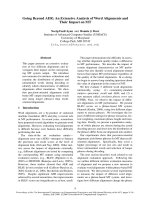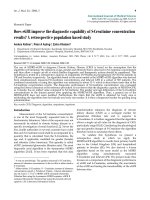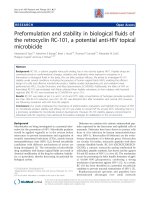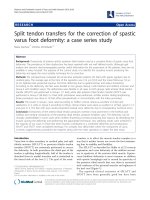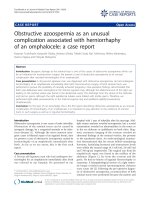Báo cáo y học: "Altered mental status, an unusual manifestation of early disseminated Lyme disease: A case repor" pdf
Bạn đang xem bản rút gọn của tài liệu. Xem và tải ngay bản đầy đủ của tài liệu tại đây (185.46 KB, 3 trang )
BioMed Central
Page 1 of 3
(page number not for citation purposes)
Journal of Medical Case Reports
Open Access
Case report
Altered mental status, an unusual manifestation of early
disseminated Lyme disease: A case report
Shiven B Chabria* and Jock Lawrason
Address: Department of Medicine, Waterbury Hospital, Waterbury, Connecticut, USA
Email: Shiven B Chabria* - ; Jock Lawrason -
* Corresponding author
Abstract
Early disseminated Lyme disease can have a myriad of central nervous system manifestations. These
run the gamut from meningitis to radiculopathy and cranial neuropathy. Here we present a case
that manifested with only acute mental status change in the setting of central nervous system
involvement with Lyme disease. A paucity of other central nervous system manifestations is rare,
especially with positive serum and cerebrospinal fluid markers. This article underscores the
importance of a high index of clinical suspicion in detection of Lyme disease related manifestations
in endemic areas.
Background
Lyme disease is a multisystem inflammatory disease
caused by spirochetes, known collectively as Borrelia
burgdorferi, which are spread by the bite of infected Ixo-
des ticks. Lyme disease was first described in studies of an
outbreak of "juvenile rheumatoid arthritis" in Connecti-
cut [1]. It is endemic in the states of Massachusetts, Con-
necticut, Maine, New Hampshire, Rhode Island, New
York, New Jersey, Pennsylvania, Delaware, Maryland,
Michigan, and Wisconsin [2]. The clinical manifestations
are usually categorized into early localized, early dissemi-
nated, and late. Early disseminated disease occurs days to
months after the tick bite and may be the first manifesta-
tion of B. burgdorferi infection, without preceding ery-
thema migrans. Alternatively, there may have been
antecedent erythema migrans and/or systemic complaints
in the early localized phase. Early disseminated Lyme dis-
ease can have many central nervous system manifesta-
tions. These run the gamut from meningitis to
radiculopathy and cranial neuropathy [3]. The range of
sequelae in untreated early disseminated Lyme disease
include rheumatologic phenomena (monoarticular or oli-
goarticular arthritis) in 60 percent neurologic manifesta-
tions (usually facial nerve palsy) in 10 percent and cardiac
complications (atrioventricular block) in 5 percent [4].
The presence of altered mental status as the sole and only
manifestation of central nervous system involvement in
early disseminated Lyme disease is presented here for dis-
cussion.
Case presentation
An eighty four year old man presented to the emergency
room after his wife found him to be behaving differently
than usual. He carried diagnoses of hypertension, history
of stroke and mild to moderate dementia. The wife noted
him to be hallucinating three to four days prior to presen-
tation. Oral intake had diminished considerably and he
was found to have decrease in functional capacity. There
was no history of fevers, chills, rigors, nausea or vomiting.
The patient and his wife had returned from Maine approx-
imately 4 weeks ago where they had been vacationing.
There was no recent or remote history of travel outside the
Published: 9 August 2007
Journal of Medical Case Reports 2007, 1:62 doi:10.1186/1752-1947-1-62
Received: 24 April 2007
Accepted: 9 August 2007
This article is available from: />© 2007 Chabria and Lawrason; licensee BioMed Central Ltd.
This is an Open Access article distributed under the terms of the Creative Commons Attribution License ( />),
which permits unrestricted use, distribution, and reproduction in any medium, provided the original work is properly cited.
Journal of Medical Case Reports 2007, 1:62 />Page 2 of 3
(page number not for citation purposes)
country. No changes were made recently to his medica-
tions.
Physical examination revealed a pleasant elderly gentle-
man. He was hearing impaired at baseline. His vital signs
including oxygen saturation were within normal limits.
Patient was noted to be agitated, confused and at times
mumbling incoherently. The wife noted this was different
from his normal baseline which was forgetful but coher-
ent. No icterus was noted though there was minimal con-
junctival pallor. Respiratory exam and cardiovascular
exam was unremarkable. No focal cranial nerve deficits
were noted and there was no neck stiffness nor was any
nuchal rigidity appreciable. Both Kernig's and Brudzin-
ski's sign were negative. The patient would mumble inco-
herently which his wife noted was new since he could talk
at baseline. Tongue was midline. Examination of his
extremities showed a bruise like lesion on the antecubital
area of his left arm.
Laboratory exam on presentation showed anemia with a
hemoglobin of 10.7 g/dl thrombocytopenia with a plate-
let count of 144 thousand/mm
3
urine analysis was com-
pletely normal. The patient did have hyponatremia at 127
mmol/L with hypochloremia of 91 mmol/L and the
serum was hypo osmolar at 267 mOsm/k. A CT scan of
the head done on presentation showed chronic white
matter changes without evidence of infarcts, tumors or
organic brain lesions. RPR was negative, TSH was normal,
B12 and folate levels were within normal limits.
Through the course of the next twenty four hours the
patient was unchanged. He at no point showed signs of
infection, the WBC count and temperature remained
within normal limits. The hyponatremia corrected on
hydration. The patient was seen by the neurologist who
recommended an EEG and MRI be done. The EEG showed
diffuse slowing consistent with encephalopathy and the
MRI showed old infarcts in the left fronto-temporal lobes.
Upon further questioning the wife regarding the bruise on
the patients left arm the wife mentioned that this proba-
bly was a "black fly" bite that he had sustained during his
trip to Maine about a month ago. However nobody had
actually seen the fly or other insect bite the patient. They
hadn't sought treatment for it since it seemed to be
improving without intervention. She was unable to
describe the initial rash fully but didn't note a central
clearing or a bull's eye configuration to it.
Based on clinical suspicion this gentleman underwent a
lumbar puncture, and both peripheral blood samples and
cerebrospinal fluid samples were sent for Lyme western
blot. CSF chemistries were remarkable for an elevated pro-
tein level of 101 mg/dl with normal glucose. Cell count
showed a WBC count of 43/mm
3
with 83% mono nuclear
cells. Red blood cells were absent. Based on this the
patient was empirically started on Ceftriaxone two grams
once a day intravenously.
Over the next few days the patient's mental status was
noted to improve. He was more coherent and awake
much to the delight of his wife. The CSF was negative for
VDRL and Herpes simplex. Both CSF and peripheral
blood ELISA with reflex Western Blot tests were positive.
Lyme IgG via Western blot was negative. However, Lyme
IgM via Western Blot was positive for IgM antibodies
against Borrelia burgdorferi antigen 23 and 41. Based on
current guidelines for interpretation of serologic tests in
Lyme disease this was viewed as a positive serologic diag-
nosis [5]. The patient improved considerably over the next
few days and was discharged to an extended care facility to
complete a four week course of antibiotics.
Discussion
This case illustrates the importance of an index of suspi-
cion for the diagnosis of Lyme involvement of the central
nervous system in a patient who at baseline had dementia.
The authors live and practice in Connecticut which is a
Lyme endemic state; as is Maine. The absence of other
attributable causes and the presence of an atypical rash
which looked more like a bruise prompted the authors to
look for possible central nervous system involvement in
Lyme disease. The initial CSF examination looked suspi-
cious for aseptic meningitis or Lyme disease. The choice to
treat awaiting serologic confirmation was based on data
suggesting that delay in treatment might lead to irreversi-
ble neurological sequelae. Also if the clinical picture is
anything but classical neuroborrelosis a lumbar puncture
with appropriate serological testing should precede treat-
ment of Lyme disease [6]. This patient improved over the
course of his inpatient stay. In general a lack of clinical
response should prompt investigation into an alternate
etiology [7]. Isolated facial nerve palsies can be treated
with oral regimens of amoxicillin, doxycyline or cefurox-
ime. But involvement of the meninges and or of the cere-
bral parenchyma require an intravenous third generation
cephalosporin. A randomized study from Sweden sug-
gests that oral doxycycline and intravenous penicillin may
be equally effective in the treatment of CNS Lyme disease
since the patients in both groups did very well [8]. How-
ever, it is difficult to extrapolate from a European experi-
ence to the United States given differences in strain of the
organism, and predominant immunogenetic types of the
patients at risk. Three to four weeks of antibiotics suffice
in most cases.
Conclusion
This case represents the complexity of medical decision
making in cases where few physical clues could be relied
upon. In the absence of typical physical and historical
Publish with BioMed Central and every
scientist can read your work free of charge
"BioMed Central will be the most significant development for
disseminating the results of biomedical research in our lifetime."
Sir Paul Nurse, Cancer Research UK
Your research papers will be:
available free of charge to the entire biomedical community
peer reviewed and published immediately upon acceptance
cited in PubMed and archived on PubMed Central
yours — you keep the copyright
Submit your manuscript here:
/>BioMedcentral
Journal of Medical Case Reports 2007, 1:62 />Page 3 of 3
(page number not for citation purposes)
findings the rash which was not typical of erythema
migrans led to the postulation of possible Lyme disease.
The endemic nature of Lyme disease in the region coupled
with an atypical rash finally led to this abstruse diagnosis.
Competing interests
The author(s) declare that they have no competing inter-
ests.
Authors' contributions
SBC was involved in the treatment and management of
this case. JL was involved in the review and preparation of
the manuscript and provided sub specialty advice and
opinion. Both authors read and approved the final manu-
script.
Acknowledgements
Full written and informed consent was obtained from the patient and his
wife for this article to be published.
References
1. Steere AC, Malawista SE, Snydman DR, Shope RE, Andiman WA, Ross
MR, Steele FM: Lyme arthritis: An epidemic of oligoarticular
arthritis in children and adults in three Connecticut commu-
nities. Arthritis Rheum 1977, 20:7.
2. Treatment of Lyme disease. Med Lett Drugs Ther 2005, 47:41.
3. Pachner AR, Steere AC: The triad of neurologic manifestations
of Lyme disease: meningitis, cranial neuritis, and radiculone-
uritis. Neurology 1985, 35:47.
4. Steere AC, Schoen RT, Taylor E: The clinical evolution of Lyme
arthritis. Ann Intern Med 1987, 107:725.
5. Dressler F, Whalen JA, Reinhardt BN, Steere AC: Western blot-
ting in the serodiagnosis of Lyme disease. J Infect Dis 1993,
167:392.
6. Pachner AR: Early disseminated Lyme disease: Lyme meningi-
tis. Am J Med 1995, 98(4A):S30.
7. Sigal LH: Summary of the first one hundred patients seen at a
Lyme disease referral center. Am J Med 1990, 88:577.
8. Karlsson M, Hammers-Berggren S, Lindquist L, Stiernstedt G, Sve-
nungsson B: Comparison of intravenous penicillin G and oral
doxycycline for treatment of Lyme neuroborreliosis. Neurol-
ogy 1994, 44:1203.
